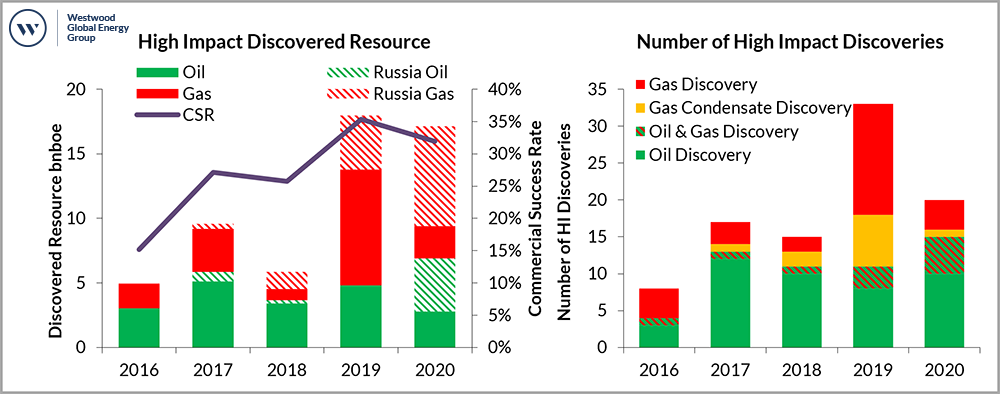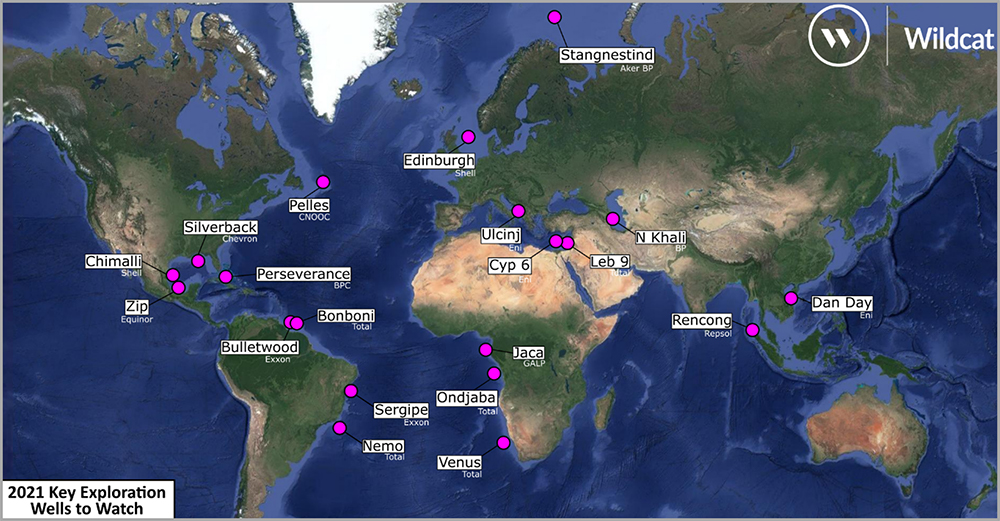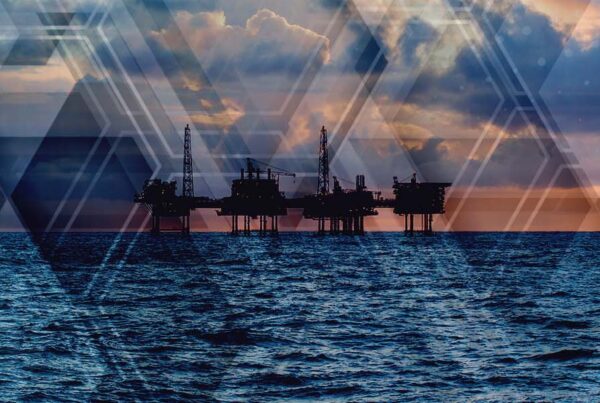High impact exploration has weathered a perfect storm of a pandemic, an oil price crash and an accelerating energy transition, and enters 2021 with a substantial drilling programme that should at least match 2020.
High-impact exploration started well in 2020 with the first quarter seeing the highest number of wells completed since Q4 2014 and commercial success rates above 30%. It was not to last. The world changed in Q2 with the Covid-19 pandemic taking hold, seeing oil prices crash and exploration budgets slashed. The impact of the pandemic became apparent in Q3 2020, with just seven high impact wells completed, the lowest quarterly figure since Westwood’s records began in 2008.
How did high-impact exploration fare in 2020?
The year closed with 72 high impact wells completed, down from 99 in 2019, but at a similar level to that seen between 2016 and 2018. Westwood estimates that ~17bnboe was discovered from high impact exploration in 2020, down slightly from 2019 but still more than 2017 and 2018 put together. Discovered oil volumes were the highest seen in the last five years (6.8bnbbl) with 10bnboe of gas also discovered. Commercial success rates remained above 30%, more than double that of 2016.
The three largest discoveries of the year were all claimed by Rosneft in the Kara Sea and West Siberia, with Russia accounting for~70% of the discovered volume, up from ~10-30% in 2017-2019 based on the figures reported by Rosneft.

Figure 1: High impact exploration discovered resource and commercial success rates, 2016-2020
Figure 2: Number of high impact discoveries, 2016-2020
Source: Westwood Wildcat
What can the industry look forward to in 2021?
Current projections for 2021 suggest that activity should at least match the 70 wells in 2020 with the potential to be higher and up to 100. Drilling plans are still fluid and will firm up in Q1. Exploration hot spots for 2021 are mainly in the Americas, particularly offshore Mexico, the Suriname-Guyana Basin and offshore Brazil. Africa is expected to have another quiet year, with only a handful of high-impact wells being drilled, however this does include the much anticipated multi-billion barrel Venus prospect in Namibia. Northwest Europe should see 10-15 high-impact wells drilled which is a similar number to 2020.
An estimated ~26bnboe is being tested by 76 wells that are considered ‘probable’ in 2021, weighted 75:25 oil to gas. This drops to ~8bnboe split 65:35 oil to gas when the chance of success is considered, reflecting the higher risk nature of some of the oil prospects being targeted. As in previous years, additional discoveries may be announced in countries where drilling plans are less transparent, especially in Russia and the Middle East.
Total, Shell and Exxon are expected to be the most active high impact explorers in 2021. Total has the widest geographic spread with wells possible in more than 10 countries. Shell is expected to have a focus in Mexico, although is also planning two high impact wells in the UK and a frontier test in Sao Tome. Exxon is focused on just Brazil and Guyana, and CNOOC is focused on Guyana, Canada and Mexico. Previously active companies such as Repsol and Tullow have cut high impact drilling significantly in response to strategy changes.
What are the Key Wells to Watch in 2021?

Figure 3: 20 exploration wells expected in 2021 highlighted by Westwood as ‘Key wells to watch’
Source: Westwood Wildcat
Westwood has highlighted 20 wells in 2021 as ‘key wells to watch’. The wells selected fall in to four categories:
- Two are frontier basin tests which, if successful, can open multi-billion barrel plays (Venus offshore Namibia, Perseverance offshore Bahamas)
- Seven are testing new plays in proven basins, or testing extensions of proven plays in to deeper water that offer benefits of large volumes with follow on potential (e.g. Silverback in the GoM, Rencong in N Sumatra)
- Six are testing extensions to proven commercial deepwater plays with significant potential albeit at some risk (e.g. Ondjaba offshore Angola, Bulletwood offshore Guyana, Nemo offshore Brazil)
- Five are large prospects in proven plays which will be high value if successful (e.g. Edinburgh offshore UK, Dan Day offshore Vietnam)
High impact exploration may have taken a few hits in 2020 from the ravages of a global pandemic, a crash in the oil price and the acceleration of the energy transition, but in no way is the game over.
Full details of Westwood’s Key Wells to Watch are available in the report published in December 2020 with commentary and analysis on the play, prospectivity, risks and implications of success. A subset of these will be presented in Westwood’s Webinar on Wednesday 20th January, 2021.
Graeme Bagley, Head of Global Exploration & Appraisal
[email protected]




